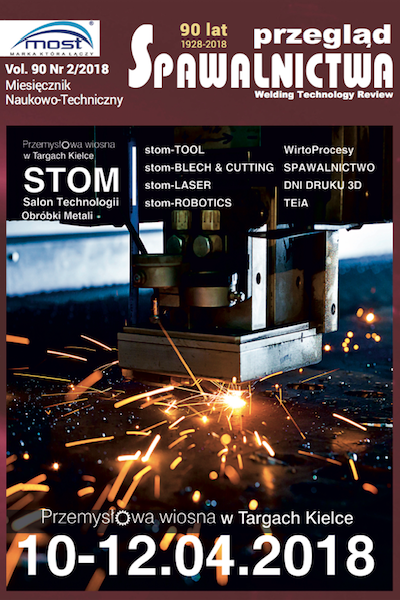Selected aspects of SPR copper sheets joining
Main Article Content
Abstract
The self-piercing riveting SPR for sheet metal joining owes its development mainly to the changing requirements of the automotive industry due to the use of new materials, especially for the body parts, and the need for their efficient joining. The observed trends to use for the structural components lightweight, yet durable, aluminum alloys, composites, plastics, etc., are examples of this tendency. The paper presents selected aspects of the attempts to use the SPR method for joining copper sheets. A numerical modeling of the process of joint formation and its loading was introduced. These analysis were verified experimentally using an industrial set-up consisting of a mobile unit for riveting equipped with a specially designed components for a measuring track settting. Simulation were carried out with commercial software based on the finite element method MSC.Marc, dedicated for the non- linear analysis. The presented results are of a qualitative nature and are the beginning of activities undertaken in cooperation with the production company, aimed at optimizing and developing internal guidelines for the design of copper sheet joints.
Downloads
Article Details
Creative Commons CC BY 4.0 https://creativecommons.org/licenses/by/4.0/
Welding Technology Review (WTR) articles are published open access under a CC BY licence (Creative Commons Attribution 4.0 International licence). The CC BY licence is the most open licence available and considered the industry 'gold standard' for open access; it is also preferred by many funders. This licence allows readers to copy and redistribute the material in any medium or format, and to alter, transform, or build upon the material, including for commercial use, providing the original author is credited.
References
Cacko R., Czyżewski P.: Numeryczne modelowanie kształtowania i obciążania połączeń nitowanych bezotworowo, in Polish, Przegląd Mechaniczny, 2005, nr 7-8, s. 50-53.
Wang C.C., Kam H.K., Cheong W.C.: Effect of tool eccentricity on the joint strength in mechanical clinching process, Proceedings of the 11th International Conference on Technology of Plasticity.
Cacko R., Czyżewski P.: Veri cation of numerical modeling of the SPR joint by experimental stack-up, Proc. Of Computer Methods in Materials Science Vol. 7, 2007, no. 1, pp.124-130.
Cacko R.: Review of different material separation criteria in numerical modeling of the self-piercing riveting process SPR, Archives of Civil and Mechanical Engineering, 2008, Vol. VIII, No. 2, pp. 21-31.
Cacko R., Czyżewski P., Kocańda A.: Initial Optimization of Self-Piercing Riveting Process by Means of FEM, The 10th Int.Conf. METAL FORMING 2004, 19-22 Wrzesień 2004, Akademia Górniczo-Hutnicza KRAKÓW, Steel Grips 2 (2004) Suppl. Metal Forming, pp. 307-310.
Cacko R., Czyżewski P.: Analiza wpływu mody kacji kształtu matrycy i nitu na proces nitowania bezotworowego SPR, Przegląd Mechaniczny, nr 7-8, 2007, s. 41-44.
Hahn O., Schulte A.: Performance and Reliability of Self-Piercing Riveted Joints in Steel and Aluminum Alloys. Mechanical Fastening Seminar, Troy, Michigan, January 1998, pp. 1-13.
Bokhari N., LaPensee M.: Self-Piercing Riveting in Automotive Applications. Mechanical Fastening Seminar, Troy, Michigan, January 1998, pp. 17-22.
TWI World Centre for Materials Joining Technology Self-Piercing Riveting database, available at www.twi.co.uk.
Porcaro, R., Hanssen, A.G., Langseth, M., Aalberg A.: Self-piercing riveting process: An experimental and numerical investigation, Journal of Materials Processing Technology, 171, 2006, pp. 10-20.
Abea, Y., Kato, T., Mori, K.: Joinability of aluminium alloy and mild steel sheets by self piercing rivet, Journal of Materials Processing Technology, 177, 2006, pp. 417-421.
Porcaro R., Hanssen A.G., Langseth M., Aalberg A.: The behaviour of a self-piercing riveted connection under quasi-static loading conditions, International Journal of Solids and Structures 43, 2006, pp. 5110-5131.
